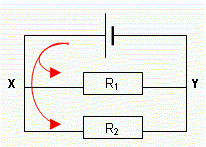GCSE Science/Parallel and series circuits answers
< GCSE ScienceAnswers to practice questions on series circuits
- Q1)Let R1 = 2Ω, R2= 3Ω, and V=5V what is the voltage across R1 and R2 ?
- The total resistance =5Ω
- So the current is = 1A
- Apply Ohm's law to each resistor in turn gives:
- V1 = 2V
- V2 = 3V
- Q2)Let R1 = 3Ω, R2= 3Ω, and V=6V what is the voltage across R1 and R2 ?
- The total resistance is 6V
- The current is therefore 1A
- V1 = 3V
- V2 = 3V
- Q3)Let R1 = 2Ω, V=5V and I= 1A what is the value of resistor R2 ?
- The total resistance = V/I
- =5/1
- = 5Ω
So R2 = 3Ω
Answers to Questions on Parallel Circuits

- Q4)You disconnect one of the bulbs, does the other stay lit?
Yes it does.
- Q5)You reconnect the disconnected bulb, does the other dim or brighten?
Ideally it should not make any difference. The brightness of the lit bulb should remain the same. (In practice the bulb will probably dim a tiny bit because of the internal resistance of the battery, but that's more advanced than this course)
- Q6)Would it be reasonable to say "each branch of the circuit behaves as if the other branch weren't there" ?
It certainly would.
- Q7) Calculate the resistance of the above pair of resistors if they had been in series rather than parallel.
R1 + R2 = 1 + 1 = 2 Ω
- Q8) A parallel circuit has two resistors, one is 2 Ω the other is 3Ω what is the total resistance of the circuit?
Let the Voltage be V.
From Ohm's Law
- current I1 = V/2 A
- current I2 = V/3 A
So the total Current I = V/2+V/3
- = V(1/2 +1/3)
- = V (5/6)
Now we Apply Ohm's Law to the circuit again only this time using the total current so that we know what the total resistance is-
R = V/I
- = V/{V(5/6)}
- = 1/(5/6) We cancel the V's
- = 6/5 To divide by a fraction, turn it upside down and multiply
- Q9) Three resistors are in parallel (three separate branches) their resistances are 2Ω,2Ω and 3 Ω what is the resistance of the circuit?
Rather than going through the whole procedure for Q8 again we note that -
1/R = 1/R1 + 1/R2 + 1/R3
- = 1/2 + 1/2 + 1/3
- = 4/3
So R = 3/4 Ω
This article is issued from Wikibooks. The text is licensed under Creative Commons - Attribution - Sharealike. Additional terms may apply for the media files.